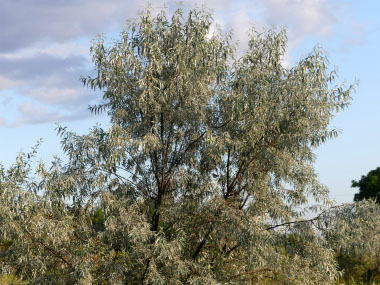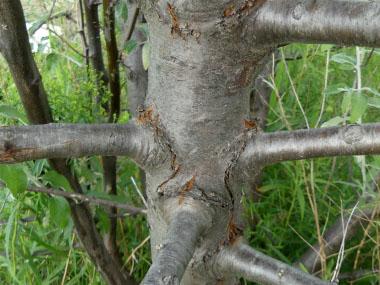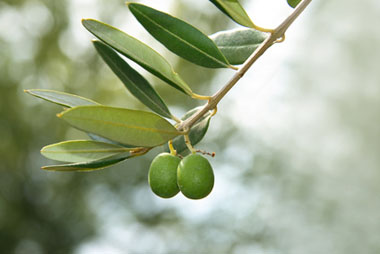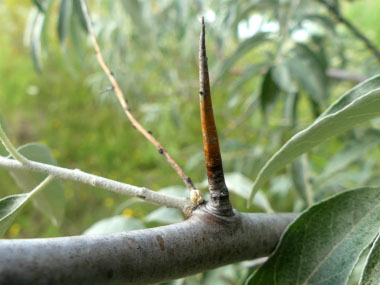








To support our efforts please browse our store (books with medicinal info, etc.).
Elaeagnus angustifolia, commonly called Russian olive is native to Europe and Asia and is a riparian tree in the Elaeagnaceae family. Elaeagnus umbellata (autumn olive berry) and Elaeagnus multiflora (goumi berry) are also in this family. Russian olive is a medium-sized deciduous tree that is drought-resistant. For a very common tree, this is generally not thought of as a good source of food for humans, yet a large number of compounds have been derived from Russian olive making this tree a good source of flavonoids, alkaloids, minerals and vitamins. The fruit of the Russian olive provides food for cedar waxwings, robins, grosbeaks, pheasants and quail.
Trunk/Bark
The bark is grayish-brown; thin, has shallow fissures, and it sheds in long strips.
Branches/Twigs
Twigs are silvery, scaly when young, becoming reddy-brown; long and slender. Dark brown branches often bear spines, are flexible and are narrow.
Height
A small tree, the Russian olive (Elaeagnus angustifolia) tops out at a height and spread of 6 metres (20').
Leaves/Needles
Leaves measure 4 to 8 cm long, are lance-shaped (without teeth) and have a short petiole. They have a dull grayish-green to an almost silvery colour with subtle veins above. They have and brown to rusty-coloured underneath. Buds are gray-brown, rounded, oblong with four silvery scales.
Flowers
Flowers measure 3 to 12 mm long, are bell-shaped with four calyx lobes. They are creamy yellow and occur in small axillary clusters on current year twigs. Flowers are highly scented and appear in early spring (typically May to June).
Fruit
Russian olive fruits measure 10 to 12 mm long; are berrylike, elliptical and occur scattered along the twigs. When ripe, they are orange-red fruit covered in silvery scales. Each fruit has one seed.
Habitat
Russian olive often grows near rivers or water corridors. It is wind resistant, tolerant of poor, dry sites, and can survive in fields. It will grow along woodland edges. It prefers full sun but tolerates part shade. Russian olive trees are found throughout the U.S.A.
Edible Parts
Fruit can be eaten raw or cooked as a seasoning in soups. They are quite dry, and somewhat mealy. The fruit can be made into jellies or sherbets. The fruit must be fully ripe before it can be enjoyed raw, if even slightly under-ripe they will taste quite astringent. Each berry contains one large seed, and this seed can be eaten raw or cooked. It can be eaten with the fruit though the seed case is rather fibrous. Gathering the seeds and roasting them makes a tasty treat. In Iran, the dried powder of Russian olive fruits mixed with milk is used to treat rheumatoid arthritis and joint pains.
Other Name
Oleaster Tree.
Recipes
Winter Survival Food Handbook

PDF Plant Magazines
Types of Wild Food
Geographic Zones Seasons
Disclaimer
EdibleWildFood.com is informational in nature. While we strive to be 100% accurate, it is solely up to the reader to ensure proper plant identification. Some wild plants are poisonous or can have serious adverse health effects.
We are not health professionals, medical doctors, nor are we nutritionists. It is up to the reader to verify nutritional information and health benefits with qualified professionals for all edible plants listed in this web site. Please click here for more information.
Why Edible Wild Food?
- Food costs are rising
- Free, wild food is readily abundant
- Wild food adds nutrition to your diet
- Wild food can help treat various medical conditions





